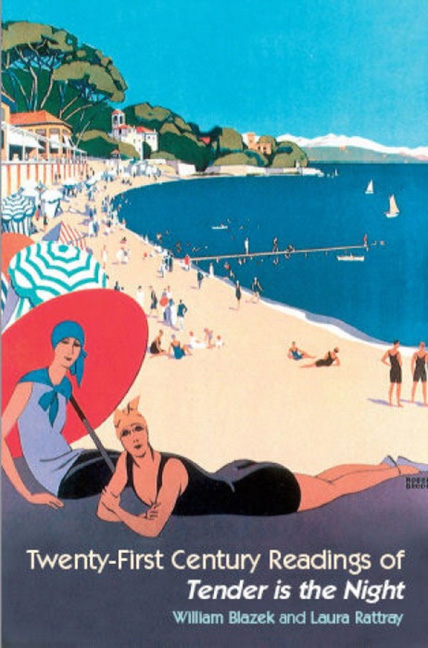Book contents
- Frontmatter
- Contents
- Acknowledgements
- List of Illustrations
- Introduction
- 1 ‘Can't We Put it in Writing?’: Some Short Precursors to Tender Is the Night
- 2 Tender Is the Night, ‘Jazzmania’, and the Ellingson Matricide
- 3 Sanatorium Society: The ‘Good’ Place in Tender Is the Night
- 4 ‘Some Fault in the Plan’: Fitzgerald's Critique of Psychiatry in Tender Is the Night
- 5 An ‘Unblinding of Eyes’: The Narrative Vision of Tender Is the Night
- 6 Si le soleil ne revenait pas: Swiss Clockwork Gone Mad in Tender Is the Night
- 7 ‘A Unity Less Conventional But Not Less Serviceable’: A Narratological History of Tender Is the Night
- 8 American Riviera: Style and Expatriation in Tender Is the Night
- 9 ‘Out Upon the Mongolian Plain’: Fitzgerald's Racial and Ethnic Cross-Identifying in Tender Is the Night
- 10 Gender Anxiety: The Unresolved Dialectic of Fitzgerald's Writing
- 11 Tender Is the Night and the Calculus of Modern War
- 12 Reading Fitzgerald Reading Keats
- Notes on Contributors
- Index
1 - ‘Can't We Put it in Writing?’: Some Short Precursors to Tender Is the Night
- Frontmatter
- Contents
- Acknowledgements
- List of Illustrations
- Introduction
- 1 ‘Can't We Put it in Writing?’: Some Short Precursors to Tender Is the Night
- 2 Tender Is the Night, ‘Jazzmania’, and the Ellingson Matricide
- 3 Sanatorium Society: The ‘Good’ Place in Tender Is the Night
- 4 ‘Some Fault in the Plan’: Fitzgerald's Critique of Psychiatry in Tender Is the Night
- 5 An ‘Unblinding of Eyes’: The Narrative Vision of Tender Is the Night
- 6 Si le soleil ne revenait pas: Swiss Clockwork Gone Mad in Tender Is the Night
- 7 ‘A Unity Less Conventional But Not Less Serviceable’: A Narratological History of Tender Is the Night
- 8 American Riviera: Style and Expatriation in Tender Is the Night
- 9 ‘Out Upon the Mongolian Plain’: Fitzgerald's Racial and Ethnic Cross-Identifying in Tender Is the Night
- 10 Gender Anxiety: The Unresolved Dialectic of Fitzgerald's Writing
- 11 Tender Is the Night and the Calculus of Modern War
- 12 Reading Fitzgerald Reading Keats
- Notes on Contributors
- Index
Summary
A spectacular beginning: three novels between 1920 and 1925, plus a prodigious number of stories and other short pieces, a celebrity marriage, a mode of life that is still a byword for glamour. No wonder that, in spite of disappointment at poor sales of The Great Gatsby, published in April 1925, the 28-year-old Fitzgerald had the confidence to write to H. L. Mencken in May, ‘I expect to spend about two years on my next novel and it ought to be more successful critically’ (Life in Letters 111). The projected novel was not what became Tender Is the Night, but an early version with a plot revolving around matricide. To the disappointment of his publisher, his public, and, principally, himself, no novel would appear until 1934.
The unsettled and self-destructive years between 1925 and 1934 were, paradoxically, among the most professionally successful of Fitzgerald's life, and saw the steady publication of short stories that comprise not only much of Fitzgerald's best, and best-paid, writing, but some of the best of the century. Novel or no novel, Fitzgerald was still a writer writing. As the results show, he was on top of his game. To dismiss this period, as Matthew Bruccoli does, as ‘The Drunkard's Holiday’ (Epic Grandeur 261– 372), or to characterize its literary output as ‘fugitive magazine pieces’, as J. Gerald Kennedy seems to (118), is unfair to what was a monumental achievement by any measure, more than sixty stories.
In December 1926, having made little progress on his novel, Fitzgerald returned from Europe to the United States. Settling that spring in Delaware, he resumed writing stories after a fifteen-month break. It is this period, between June 1927 and June 1931, on which I shall focus, a period that falls between Fitzgerald's virtual abandonment of the matricide plot for his novel, and the beginning of concentrated work on Tender Is the Night.
There are more than thirty stories from this four-year period, too many for a comprehensive account. Bryant Mangum, who gives a useful overview of all of Fitzgerald's stories in relation to his novels, has described the popular magazines that published the stories as ‘workshops’ for the novels, a true but somewhat limiting insight (Cambridge Companion 67).
- Type
- Chapter
- Information
- Twenty-First Century Readings of ‘Tender is the Night’ , pp. 16 - 33Publisher: Liverpool University PressPrint publication year: 2007

